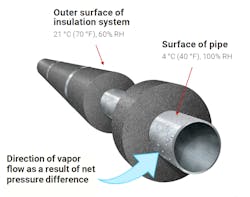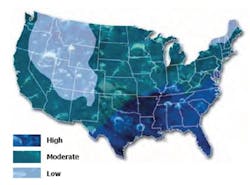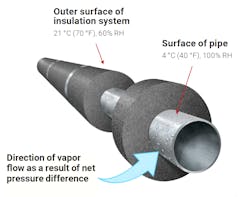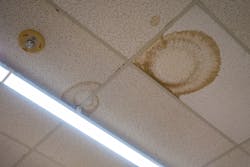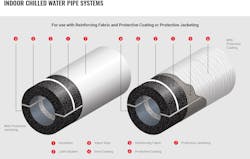Insulating to Protect Chilled Water Systems, By Region
By ALEC CUSICK, Technical Services Engineer, Owens Corning
As facilities shuttered during the pandemic now reopen, and new industrial, commercial and large-scale residential sites come online, it is important to consider the influence that geographic location plays on the protections needed for chilled water systems.
Ambient moisture levels and temperature are major risks to the long-term, efficient functioning of chilled water systems, and some areas – like coastal regions or other warm, humid locations – call for heightened attention to the insulation material and system design used. According to the U.S. EPA, ambient moisture in outdoor air provides the majority of the annual humidity load for many buildings.1
However, planning for both average and startup or restart conditions that exceed system operating parameters along with using an impermeable insulation, can help protect the lifespan and cost-effective functioning of a chilled water system. Correctly installed, adequate insulation can help mitigate the risk of damage, corrosion development and need for unexpected repairs from moisture invading insulation or condensation on outer layers.
Vapor drive, humidity and locational challenge
Temperature and relative humidity can present problems for insulated chilled water systems. As ambient temperature increases, air has the ability to hold more moisture, i.e., it has a higher absolute humidity (lb./ft3x10-4; kg/m3x10-4). Relative humidity describes how much moisture is currently in the air compared to how much could be present.
In addition, as temperature increases, the vapor pressure rises (in-Hg; cm-Hg). That pressure is created by moisture in liquid and vapor forms existing at equilibrium. However, when the air temperature falls or when the balanced system encounters a colder object, the equilibrium is upset and moisture condenses as dew until a new point of balance is established. The temperature where the condensation begins to form is the dewpoint.
The potential for high vapor pressure to result in condensation is what creates challenges for permeable insulation used to protect chilled water systems in warm areas. Chilled water pipes can create an imbalance in vapor pressure because the inside of the insulation – nearer the pipe – is colder than the outer edge. Water vapor seeks to permeate the insulation in an attempt to reach the colder area, condense, and set a new point of equilibrium. This mechanism is vapor pressure drive and although it exists anywhere that insulated pipes are colder than outside air, the drive increases as the difference between the inside conditions and outside conditions widens.
To put it another way, the warmer a humid region is, the more moisture the ambient air can hold. This increases risk for moisture to enter an insulated chilled water system because the vapor pressure drive is higher. As chilled water systems typically operate from 4.4°C to 7.2°C (40°F to 45°F) the pressure drive in a warm, humid region – like a southern U.S. coastal area – can be extreme.
When a strong vapor pressure drive encounters permeable insulation surrounding chilled pipes, moisture can penetrate the system and damage the insulation, the chilled water pipes and, potentially, surrounding parts of the building or nearby equipment.
Accounting for moisture damage
When vapor drive condenses moisture onto or pushes it into the insulation surrounding chilled water pipes, two different types of damage can occur. The first presents outward signs as water potentially condenses and drips onto the floor, walls, ceilings or nearby equipment causing additional damage to the dripped-upon objects. Other evident problems that can develop include the growth of mold or mildew on insulation or insulation jacketing and a potential drop in air quality.
However, the second type of damage can be much harder to see because it involves moisture penetrating into insulation and potentially negatively altering overall system operating costs, efficiency, lifespan and thermal conductivity.
When moisture penetrates an insulation system, it can damage the insulation. But, any water present also has the opportunity to collect between the insulation and the chilled pipes. This interaction increases the possibility that corrosion under insulation (CUI) may form or that valves and fittings start to degrade raising the potential that system repairs will be needed. Moisture in insulation also can reduce system efficiency by increasing energy use and raising operational costs.
Additionally, a series of studies explored how the thermal conductivity of various kinds of insulation changed when moisture was present.2, 3 Different types of insulating materials presented a range of thermal conductivity; however, data consistently demonstrated that raising moisture levels had a negative effect. Work with open-cell insulation found that adding 1% moisture content to insulation could result in up to a 23% increase in thermal conductivity for the material.3
Limiting system risk with insulation system design
Despite the range of damage that chilled water systems can sustain from regional conditions like humidity, there are several straightforward steps that can be taken to help mitigate or reduce the risk of damage developing. One way to provide a long-term, efficient insulation for a chilled water system is to use a material with low permeability.4 This practice also can help provide an economical solution for the lifespan of the system.
An initial aspect of designing the insulation system should be to ensure that the outer surface temperature of the insulation remains above the dewpoint for the expected range of ambient conditions. A second element to consider is the permeability of the insulation selected. Even if the outer layer of insulation remains above the dewpoint, if the insulation is permeable, moisture could still enter the material and condense upon reaching colder sections or the chilled pipes if damage to the vapor retarder jacket occurs. However, using an impermeable material, such as closed-cell, cellular glass insulation, would help prevent this occurrence.
Extreme conditions are an additional factor to consider when designing insulation systems for chilled water systems. To provide thorough protection, insulation should be able to function beyond average ambient conditions. Failing to account for extreme humidity events for specific spaces or how the system functions outside of typical design parameters – such as when the building is starting or restarting operations – may mean that the insulation used is not sufficiently thick to prevent condensation from forming.
A common start of moisture problems for chilled water systems comes at startup, because systems are stressed by being activated before the building is entirely enclosed from the outside environment. This practice means chilled water systems may begin operation in conditions that exceed the original design specifications – if these extreme conditions were not accounted for in the design of the system. This would potentially allow the buildup of condensation or intrusion of moisture into a permeable insulation. However, if the insulation used is correctly installed and impermeable, like cellular glass insulation, the system has additional resistance to moisture penetration in harsh conditions.
Another step for insulation system design is to ensure that the material selected has been tested using the correct metric for a chilled water system functioning in a warm, humid area.5 The “wet cup” testing process from ASTM E96 provides a way to assess material function while protecting chilled water systems in challenging regions.
The warmer and moister the location, the more risk a chilled water system faces from ambient conditions. Using impermeable materials, like cellular glass insulation, helps reduce that risk by preventing moisture from collecting on insulation or saturating it. Keeping insulation dry helps maintain its thermal and energy efficiency, reduces risk of corrosion under insulation developing and potentially limits the need for unexpected repairs. Additionally, taking proactive steps to ensure insulation integrity may reduce system lifecycle expense as replacing failed insulation can cost three to five times more than the initial installation.5
Correctly installing impermeable insulation designed to keep the outer layer of material above the dewpoint and resistant to vapor pressure drive, in addition to accounting for extreme events, provides a straightforward path to protecting a chilled water system’s long-term performance, even in challenging locations.
##########
A technical services engineer with Owens Corning, the author is also an ASHRAE Technical Committee representative, an NIA Certified Insulation Energy Appraiser, and an ITC Certified Level 1 Infrared Thermographer.
##########
References
- U.S. EPA. Moisture Control Guidance for Building Design, Construction and Maintenance, EPA 402-F-13053, (2013).
- Kehrer et al. (2002), Cremaschi, Cai, Ghajar et al. (2012), Jerman and Cerny (2012).
- A.M. Gusyachkin et al 2019 IOP Conf. Ser.: Mater. Sci. Eng. 570012029.
- ASHRAE Handbook — Fundamentals (2017).
- Owens Corning. FOAMGLAS® Insulation Systems for Chilled Water Applications, (2020).
© 2021. Owens Corning. All Rights Reserved.
© 2021. Pittsburgh Corning, LLC. All Rights Reserved.
